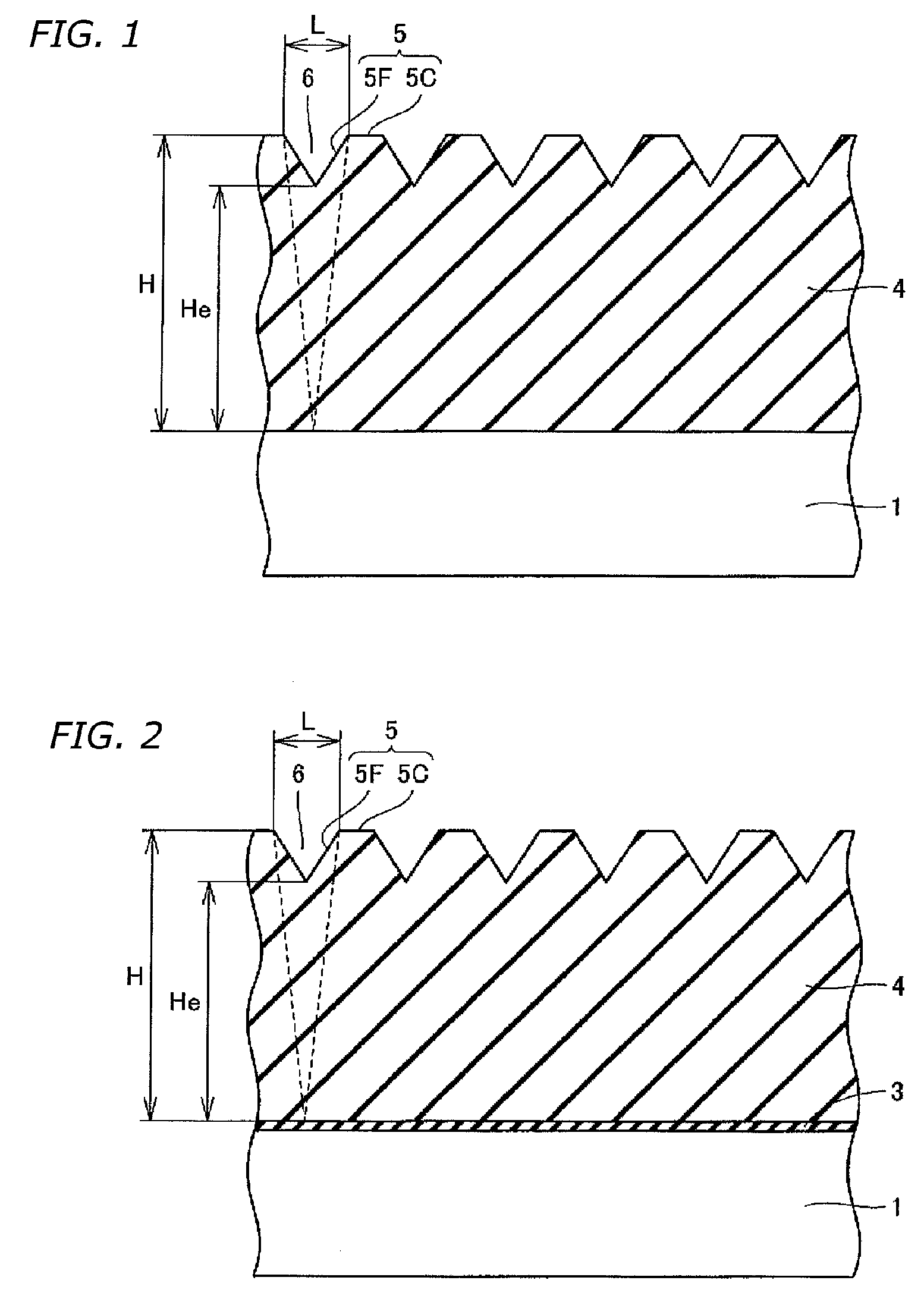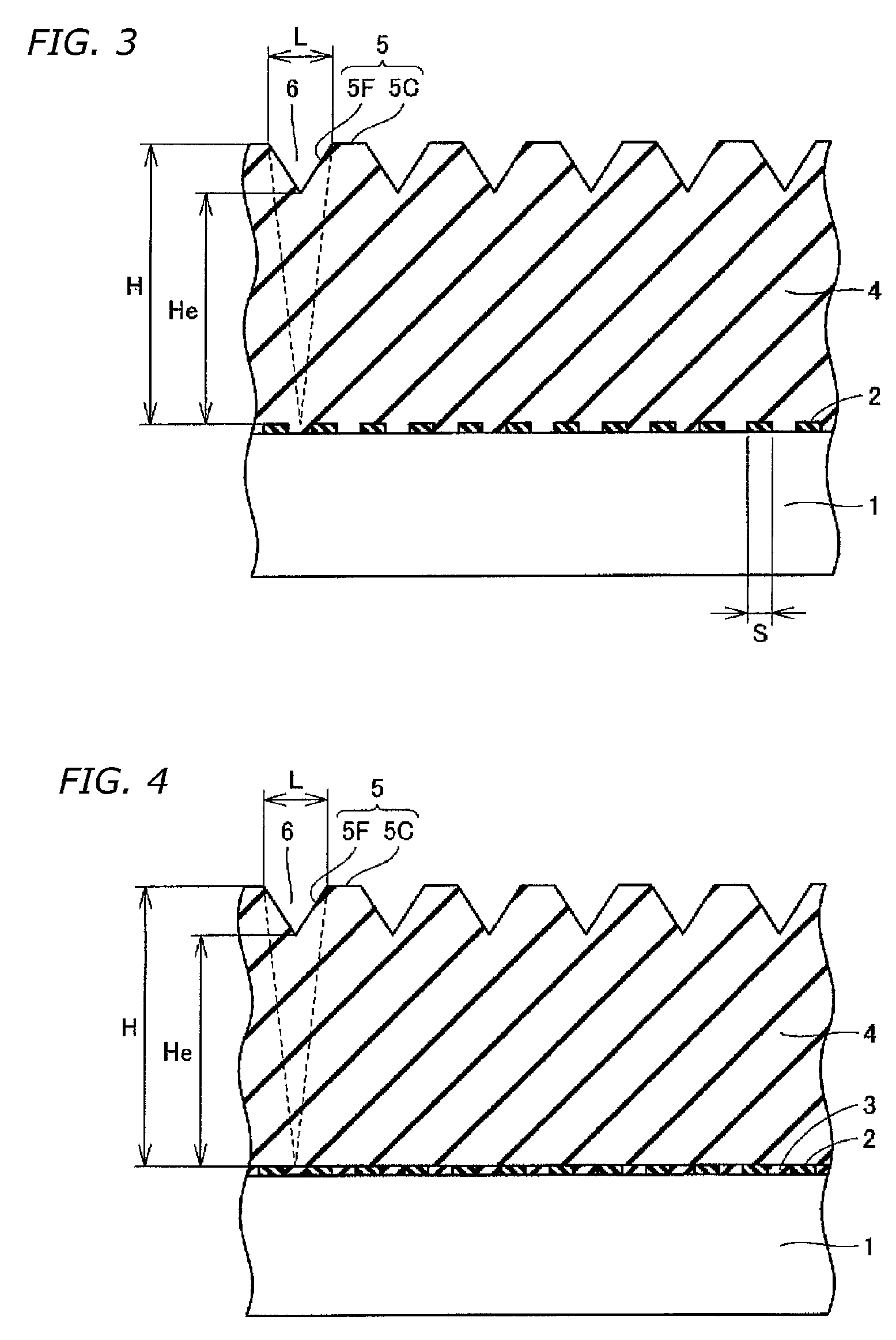Method of manufacturing GaN crystal substrate
a technology of monocrystalline substrates and monocrystalline crystals, which is applied in the direction of crystal growth process, polycrystalline material growth, chemically reactive gases, etc., can solve the problem of lessening the effective gan crystal portion that can be obtained, and achieves high substrate acquisition rate, increase the effective gan crystal portion, and inhibit the enlargement of the pit size
- Summary
- Abstract
- Description
- Claims
- Application Information
AI Technical Summary
Benefits of technology
Problems solved by technology
Method used
Image
Examples
embodiment examples
Examples 1 through 4, Comparative Example 1
[0039]With reference to FIG. 1, the growing of a GaN crystal 4 was carried out by an HVPE technique using a GaN substrate, which is a native substrate, as a growth substrate 1. The HVPE equipment utilized in the present examples was provided with a boat, disposed inside a reactor, in which Ga metal is accommodated, and was configured to enable introducing HCl gas and a carrier gas directed toward the boat, and, with the growth substrate placed below the boat, to enable introducing NH3 gas and a carrier gas in the vicinity of the growth substrate. A heater was provided on the periphery of the reactor so that the boat and the growth substrate could be heated. An exhaust port is provided below the reactor, and the pressure is reduced by a vacuum pump. A Ga melt in the boat that is heated at 850° C. or higher reacts with the HCl gas, creating a GaCl gas, which reacts with the NH3 gas, making it possible to grow a GaN crystal on the growth subst...
examples 5 through 8
, Comparative Example 2
[0041]With reference to FIG. 3, using GaN substrates, which are native substrates, as the growth substrate 1, aperture-window-defining mask layers 2 were formed on the growth substrates, followed by growing GaN crystals 4 over the mask layers 2 by an HVPE technique.
[0042]Each aperture-window-defining mask layer was formed by forming a 100 nm-thick SiO2 layer by CVD, and thereafter forming by photolithography aperture windows that are arrayed in a dotted pattern in which three adjacent aperture windows (squares 2 μm to a side) sit at the vertexes of equilateral triangles (the distance between the adjacent aperture windows being 4 μm).
[0043]By an HVPE technique, GaN crystals were grown to a thickness of about 2 mm on growth substrates at the growth temperatures, GaCl partial pressures, NH3 partial pressures, and growth rates set forth in Table I. Then, the GaN crystals were sliced with a wire saw or an internal-diameter saw and the surfaces were polished to obta...
examples 9 through 12
, Comparative Example 3
[0045]With reference to FIG. 3, using GaAs substrates, which are foreign substrates, as the growth substrate 1, GaN buffer layers 3 were formed on the growth substrates, followed by growing GaN crystals 4 thereon.
[0046]For the GaN buffer layers 3, amorphous layers having a thickness of about 70 nm were formed, using an HVPE technique, by heating and holding the growth substrate 1 to 500° C. at a GaCl partial pressure of 0.2 kPa and a NH3 partial pressure of 15 kPa.
[0047]With an HVPE technique, GaN crystals were grown to a thickness of about 2 mm over the GaN buffer layers 3 at the growth temperatures, GaCl partial pressures, NH3 partial pressures, and growth rates set forth in Table II. Then, the GaAs substrates were removed by etching in aqua regia, and thereafter the GaN crystals were sliced with a wire saw or an internal-diameter saw and their surfaces polished to obtain GaN crystal substrates having a predetermined thickness. The dislocation densities, pit...
PUM
| Property | Measurement | Unit |
|---|---|---|
| crystal-growth temperature | aaaaa | aaaaa |
| partial pressure | aaaaa | aaaaa |
| partial pressure | aaaaa | aaaaa |
Abstract
Description
Claims
Application Information
 Login to View More
Login to View More - R&D
- Intellectual Property
- Life Sciences
- Materials
- Tech Scout
- Unparalleled Data Quality
- Higher Quality Content
- 60% Fewer Hallucinations
Browse by: Latest US Patents, China's latest patents, Technical Efficacy Thesaurus, Application Domain, Technology Topic, Popular Technical Reports.
© 2025 PatSnap. All rights reserved.Legal|Privacy policy|Modern Slavery Act Transparency Statement|Sitemap|About US| Contact US: help@patsnap.com



